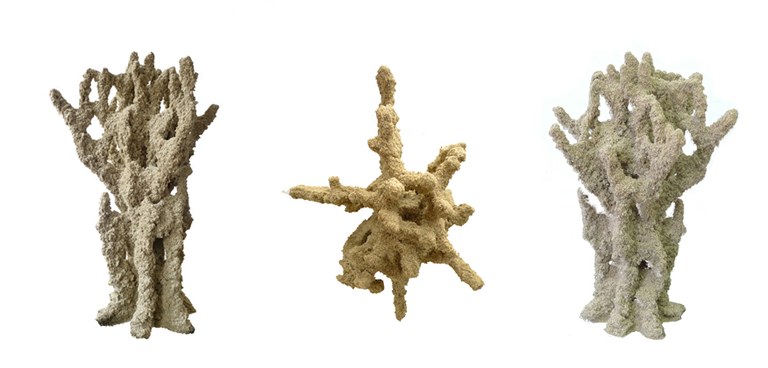I have blogged about how 3D printing could change the game for the saltwater aquarium hobby with my series on using 3D printers to design and develop products at home inexpensively for use with aquariums. 3D printers like the Makerbot and Reprap extrude a hot noodle of plastic and build a part layer-by-layer. This project diverges from that aspect and instead sprays a soil / binder mixture three dimensionally using a robot to build a shape. The project is called Stone Spray.
The Stone Spray project is a new technology developed by architects Petr Novikov, Inder Shergill and Anna Kulik in conjunction with the Institute for Advanced Architecture of Catalonia, supervised by Marta Male-Alemany, Jordi Portell and Miquel Lloveras.
As mentioned, a robot sprays a soil / binder mix into a three-dimensional shape and then dries in place. The technology is reportedly ecologically friendly using very little energy to function and can run off of solar power. The group also has an ebook explaining the project in more detail.
Take a look at some of the shapes that the project has created:
-

- The Sand Wall experiment showed that the the system can be aplied in the architectural scale. The result represents a part of the wall. It is structurally strong and can support not only itself but even bear a load. Size: 500 mm x 150 mm x 400 mm.
-

- The Sand Tree experiment explored the possibilities of multi directional spraying without the scaffolding. As a result the rules of length to angle proportions were created. Size: 200 mm x 200 mm x 400 mm.
-

- This stool is replicating the the first model done with formwork, but in this case the metal wire is not used. The structure holds itself without any support material, the only materials used are sand and soil-solidifier. As well the size of the stool was increased. Size: 400 mm x 400 mm x 400 mm.
-

- This stool was made using a Stone Spray nozzle and wire scaffolding. It took only 3 hours to make it and 1 hour for it to solidify completely. Size: 200 mm x 200 mm x 200 mm.
(via Ponoko)










0 Comments